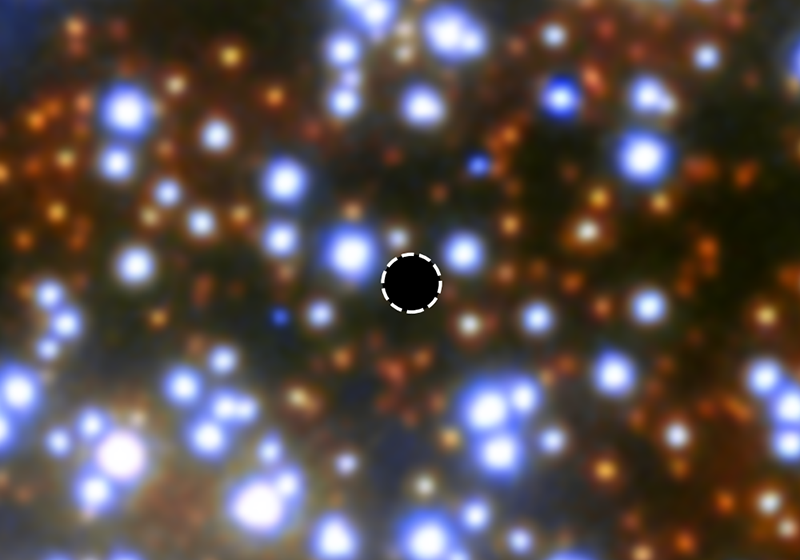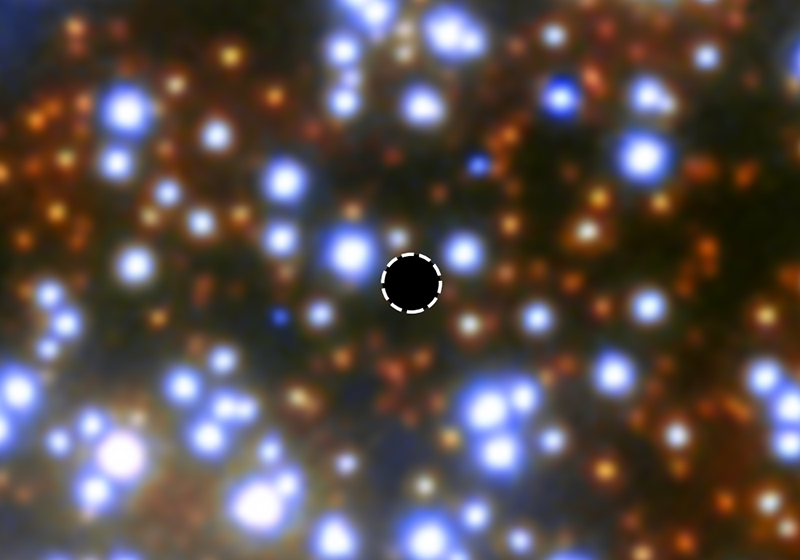An Elusive Black Hole Comes into View
The conglomerate of stars known as Omega Centauri hides a sought-after black hole prize—a so-called intermediate-mass black hole—according to a newly released analysis of two decades of Hubble Space Telescope images [1]. Only a handful of such black holes have previously been spotted, but those sightings, which include claims for Omega Centauri’s black hole, have been hotly debated. Confirming the existence of intermediate-mass black holes could help uncover how bulkier, supermassive black holes formed in the early Universe, a key open question for cosmologists and astrophysicists. “There have been numerous claims that an intermediate-mass back hole lies at the center of Omega Centauri,” says Maximillian Häberle, a PhD student at the Max Planck Institute for Astronomy, Germany, and one of the researchers behind the new finding. “To finally confirm it’s there in a way that we can really trust is very exciting.”
A multitude of verified observations exist for black holes with masses that sit at the extremes of the black hole mass spectrum. At the lower end of the scale, stellar-mass black holes—those with masses up to 100 times that of our Sun—can be revealed, for example, through x-ray observations by space telescopes such as NASA’s Chandra X-ray Observatory. The intense x-ray emission comes from heating of gas and debris that flows toward the black hole as it gobbles a circling star. Gravitational-wave detectors also now routinely detect the space-morphing signals that emanate from two co-orbiting stellar-mass black holes crashing together. Meanwhile, at the upper end of the black hole mass spectrum, supermassive black holes—those with masses greater than that of 100,000 Suns—can be revealed by the distorted orbits of nearby stars. These gargantuan objects can also be detected in isolation, as their mass can significantly distort the path of light coming from objects in their background.
In theory, the same detection methods should work for finding signals of intermediate-sized black holes, ones with masses between 100 and 100,000 times that of the Sun. But the sizes of these objects create problems. For example, current gravitational-wave detectors aren’t sufficiently sensitive to the low frequencies predicted for gravitational waves produced by mergers of two intermediate-mass black holes. These black holes’ suspected locations—in dense star conglomerates—also pose an issue for x-ray-based detections. While Omega Centauri contains over 10 million stars, the actual matter density of the cluster is low, so there is little gas for the black hole to interact with. No easily measurable x-ray signal will likely emanate from the surroundings of an intermediate-mass black hole in a globular cluster such as Omega Centauri, Häberle says.
These observational difficulties left open the question of the existence of intermediate-mass black holes. “Had we not found them because it’s hard to do with current techniques, or had we not found them because they didn’t exist,” Häberle says. “We didn’t know.”
To determine what lies at the heart of Omega Centauri, Häberle and his colleagues turned to star tracking. Taking 20 years of publicly available Hubble Space Telescope images, the researchers followed the paths of 1.4 million stars located in the globular cluster. They then determined each star’s so-called proper motion, which is a measure of how much its apparent position in the sky changes because of the star’s motion relative to the Sun.
Analysis of the stars’ proper motions reveals seven stars moving at anomalously high speeds. These stars are all located within 0.26 light-years of Omega Centauri’s center and are moving so fast that, if the cluster contained no black hole, they would have escaped its gravitational grasp long ago. Using data from the five fastest moving of these stars, the researchers calculated the unseen mass needed to keep them in place, putting it at a minimum of 8200 times the mass of the Sun. This value lies securely in intermediate-mass territory, says Häberle. “It’s one data point, so we can’t make any broad conclusions yet about intermediate-mass black holes. But it shows that we can find them this way.”
Jenny Greene, who studies intermediate-mass black holes at Princeton University, agrees. “The only stellar system for which we had been able to track individual stellar motions around a central black hole is our own Milky Way, which houses a supermassive black hole. That work was awarded a Nobel Prize,” she says. “This is really a very exciting moment, finding that there is a second black hole that we can study in a similar way.”
Häberle notes that he and his colleagues did test other schemes that could have caused the seven stars’ fast speeds, including collisions with other stars. But none of the tested scenarios produced data that matched the observations. “They couldn’t explain the very high concentration of stars’ found at the cluster’s center, or the appearance of the seven very fast stars.” Häberle says. Such interactions would also likely kick stars out of the cluster, and the researchers found no evidence of that having happened.
The researchers also ruled out there being more than one black hole at Omega Centauri’s center, a possibility raised in previous star-tracking studies. In those studies, the center of the cluster was less tightly constrained, making the exact location of any black hole uncertain. Also, fewer stars were followed over a much shorter time, limiting the ability to find the fast-moving stars needed to reveal the black hole’s presence. Previous data just weren’t precise enough, Häberle says. Greene also notes that there previously was ambiguity about whether Omega Centauri housed one larger black hole or several smaller black holes and neutron stars, as both scenarios fit the data. Solving that ambiguity is “a major development,” she says.
Finding this black hole—and potentially others of similar sizes—could help cosmologists and astrophysicists understand the formation process of gargantuan black holes, such as M87*, the first black hole to be directly imaged. Researchers think that intermediate black holes might have been the seeds that grew into M87*-sized black hole monsters . “These intermediate-mass black holes provide us with insights into how black holes first grew in the early years of the Universe, probably only hundreds of millions of years after the big bang,” Greene says. “Questions like ‘which came first, the black hole or the Galaxy’ will be answered by this discovery combined with our new view of early black hole growth from the JWST.”
–Katherine Wright
Katherine Wright is the Deputy Editor of Physics Magazine.
References
- M. Häberle et al., “Fast-moving stars around an intermediate-mass black hole in ω Centauri,” Nature 631, 285 (2024).





